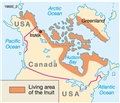What is the origin of the word "kayak"?
by John Rich
Last month we learned the origin of the word "canoe", which we discovered came from the Arawak Indians of the Caribean Islands, and was brought to the new world by Christopher Columbus. This month, we'll look at the origin of the word "kayak".
According to the Merriam-Webster dictionary, and other etymology sources, "kayak" derives from the Inuit Eskimo word "qayaq" - spelled just like "kayak", except that it has q's instead of k's. "Qayaq" is defined as an Eskimo canoe made of a frame covered with skins, except for a small opening in the center, and propelled by a double-bladed paddle. The first known usage of the modern word goes back over 250 years to 1757.
The Inuit are descendants of Paleolithic hunters from Mongolia who migrated across Siberia, eastward over the
frozen land bridges of the Bering Strait, and into the North American continent
in a series of migrations four thousand years ago.
The word "kayak" is thought to have come into European languages from Dutch or Danish whalers, who encountered Inuit Eskimos on Greenland in their sea travels hunting for whales in wooden sailing ships. Other Europeans later encountered the Inuit while looking for a northwest passage trade route to the Orient.

|
|
 |
|
 |
Inuit range map
|
|
Inuit village, 1575
|
|
Inuit family
|
The Inuit people used their kayaks to
hunt on inland lakes, rivers and coastal waters, and throughout their habitation range, in the Arctic Ocean, North Atlantic,
Bering Sea and North Pacific. Kayaks have been around for at least
4,000 years!
| |
 |
| |
Inuit kayak frame |
Inuit kayaks were constructed by making a framework of wood or whale bones, and then stitching animal skins over the framework. The western Inuit used wood frames since trees were available to them, and the eastern Inuit used whalebones, due to their treeless environment. Their tools were made of stone, antler, ivory and copper - they had no iron until trade began with Europeans. Each kayak was custom built by and for the man who would use it, with assistance from his wife who would stitch the skins. The skins came from seals, sea lions, caribou or walrus. The seams on the skins were waterproof because the stitching would not penetrate completely through, and the skins were treated with oil every 4-8 days to keep them waterproof.
The length of the kayak was
| |
 |
| |
Inuit kayak
|
typically three times the span of the owner's outstretched arms. Typical dimensions were about 17 feet long by 20–22 inches wide by 7 inches deep. The kayaks also featured a tuilik - a skin-jacket around the cockpit and paddler that created a waterproof seal, just like our modern synthetic spray skirts. The eskimo-roll was the method to get back upright after a tip-over, as the waters were far too cold to be immersed in for very long.
So there you have it - the word "kayak" comes from the Inuit Eskimos who have inhabited the frozen northern reaches of North America for over 4,000 years! The kayak is a boat design that has been proven by time and hard usage, and is so near to perfection that it has remained little-changed over the centuries.
 |
| The author, John Rich |